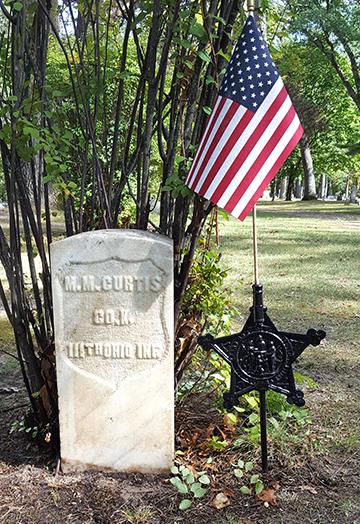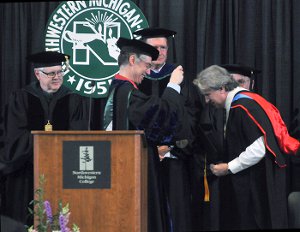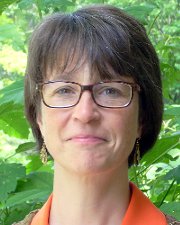Dec 23, 2017 | Intercom, Student News
October 11, 2017
 NMC welding students Andrew DuBois and Michael StolarczykSome NMC welding students are getting a dose of American history on top of this semester’s classes.
NMC welding students Andrew DuBois and Michael StolarczykSome NMC welding students are getting a dose of American history on top of this semester’s classes.
They’re helping to restore Civil War markers placed on the graves of Union Army veterans in northern Michigan cemeteries. Thanks to an instructor’s idea, the extracurricular project is increasing their skills and their citizenship, one cast iron star at a time.
Adjunct electrical instructor Jeff Morse is a member of the Sons of Union Veterans of the Civil War, a national group that works to honor the memory of the soldiers killed between 1861-65. A feature of the Union graves the group charges itself with maintaining is a cast iron star flagholder, inserted into the ground with double spikes.
 A Civil War marker repaired by NMC welding students“Over the years they became no match to power lawn mowers and brutal northern Michigan winters. Many markers became rusty and either one or both of the spikes had been broken off,” Morse said.
A Civil War marker repaired by NMC welding students“Over the years they became no match to power lawn mowers and brutal northern Michigan winters. Many markers became rusty and either one or both of the spikes had been broken off,” Morse said.
He mentioned it to welding instructor Devan DePauw, who agreed to take on repair as an extracurricular project with student volunteers. Students cut off the double legs, grind and prepare the stars for welding, and then weld one spike in a new, center position.
It’s an opportunity to learn new techniques from the typical steel-to-steel welding they do in class.
“Cast iron is notoriously difficult to weld,” DePauw said. Students are learning a “brazing” technique that uses a bronze filler to weld the spike back on.
It’s also an opportunity to apply their knowledge for a greater good.
“I like doing stuff that matters. This epitomizes that,” said Michael Stolarczyk, 18, of Traverse City.
“I just think it’s a good cause,” said Andrew DuBois, 28, of Flint.
Group member Scott Schwander, who has been cleaning the headstones as well, returns the repaired star flagholders to the graves. He started with Oakwood Cemetery near main campus, where about 300 Union veterans are buried. The Robert Finch Camp of which both Schwander and Morse are members serves 16 northern Michigan counties and estimates that more than 1,000 Union veterans are buried in the five-county Grand Traverse region.
Camp commander Ted Matti, sees the project as a win–win.
“Being they’re in a welding program, they have to work with various kinds of metal,” he said. “Any time you can get involved with anything in the community of historic significance, or helping others, that’s all part of being a citizen in the community, and that’s a good lesson, too.”
Dec 23, 2017 | Intercom
April 22, 2015
 At just 21 years old, Traverse City native Nick Alpers has checked off a lot of life’s milestones already. He’s earned his bachelor’s degree, married, and is working full-time in his chosen field of mechanical engineering.
At just 21 years old, Traverse City native Nick Alpers has checked off a lot of life’s milestones already. He’s earned his bachelor’s degree, married, and is working full-time in his chosen field of mechanical engineering.
The 2012 NMC graduate is unique in another way, too: Alpers, who graduated summa cum laude from Saginaw Valley State University last year, has zero student loan debt.
Zero as in zip. Zilch. None. As in, a stark contrast to his peers. Statewide, 63 percent of Michigan’s 2013 bachelor’s graduates took on student debt, according to the Project on Student Debt. On average, each owes more than $29,000.
What’s the difference? Simply put, motivation and NMC dual enrollment.
Dual enrolled in 2010
Alpers dual-enrolled in NMC as a senior at Traverse City Central, back in 2010. He took 28 credits that year, more than half of what he needed for his engineering certificate, all paid for by his high school. He attended NMC for another year and worked in the math lab before transferring to SVSU in 2012. There he completed the last two years of his bachelor’s in a year and a half. Now, his paycheck from Nexteer Automotive, a Saginaw manufacturer of steering columns and gears, belongs to just him and his wife Kaitlyn (Green) Alpers, a pre-physician’s assistant student at SVSU.
“I know that some people are in their 30s and still paying off debts. Now I can allocate that money to something else,” said Alpers.
Financial and academic advantages
Besides the financial advantage, Alpers speaks highly of NMC’s academic rigor, noting that his GPA at Saginaw Valley was higher than at NMC.
“It was definitely worth it. It helps you to prepare,” said Alpers, whose two older brothers also attended NMC. “I came down here and I thought (SVSU) was a breeze.”
Not too far down the road, the “something else” might be getting home. Kaitlyn, who also dual-enrolled at NMC for her senior year in 2011-12, has her eye on a master’s PA program that Grand Valley recently started at NMC’s University Center.
Dec 23, 2017 | Intercom, Student News
November 22, 2017
 In this season of gratitude, quality child care is near the top of the list for the young families fortunate enough to have found it.
In this season of gratitude, quality child care is near the top of the list for the young families fortunate enough to have found it.
This fall, one NMC alumna took a step toward filling that crucial community need by doubling her home child care capacity, including more desperately-needed infant care. Alison Burns’ Healthy Start Child Care in Traverse City also now employs two NMC child development students, (including Emily Spica, above) providing them valuable work experience.
 A licensed provider in Michigan since 1996, Burns (right) originally chose child care as a way to stay home with her own three children. Until this year, her license limited her to six children in care simultaneously, only two of whom could be under a year old. However, Burns self-limited infant enrollment to one. She frequently had a waiting list, and felt badly for the families she had to turn away.
A licensed provider in Michigan since 1996, Burns (right) originally chose child care as a way to stay home with her own three children. Until this year, her license limited her to six children in care simultaneously, only two of whom could be under a year old. However, Burns self-limited infant enrollment to one. She frequently had a waiting list, and felt badly for the families she had to turn away.
“There’s such a demand for infant care,” she said.
Then this fall, timing and preparation coincided, allowing Burns to help meet that demand.
Back in 2011, inspired to learn more about children with special needs after one came into her care, Burns enrolled in an Exceptional Child psychology class at NMC. Child development program coordinator and instructor Cheryl Bloomquist then persuaded her to complete the entire Child Development certificate course sequence — 32 credit hours. Even after practicing child care for 15 years, Burns found herself invigorated in the classroom.
“It reinforced what I already knew, (and) I learned so much,” she said. An Infant and Toddler Development class was especially beneficial, she said, bolstering her knowledge of best practices for that age group and confidence working with them.
She completed her certificate in 2013 and returned to running her six-child daycare home. She also made time to serve on Bloomquist’s Early Childhood Advisory Committee.
“Her input is so valuable, because I don’t always have a family home provider there,” Bloomquist said.
Fast-forward to this fall, when Burns’ youngest daughter left for college, creating more physical space for child care in their home. Simultaneously Burns was up for relicensing, and the lack of child care regionally had become an acknowledged obstacle to continued economic growth.
“Babies need care, and they need good care,” said Bloomquist. “They take up a lot of space and they take up a lot of employees.”
Burns decided to expand her license to allow her to care for 12 children, up to four of whom can be younger than 18 months. All those slots are filled, and in fact she cares for 19 different children over the course of a week, since some attend part-time.
She also turned to NMC to find staff. Both Kalee Lown, lead infant and toddler teacher, and Spica, lead preschool teacher, are NMC students. On a recent brisk morning, Spica played with preschoolers in Burns’ backyard while Lown and Burns each held an infant, and another napped.
“I get to apply the things we’re learning in class,” said Spica, who will graduate next spring. “A lot of (the work) coincides with the assignments we’re given.”
Burns empowers them to use their education on the job.
“These teachers are teachers. They’re not just waiting for me to tell them what to do,” she said.
“Now she is the mentor,” Bloomquist said. “It’s just been a really good fit.”
For information on Healthy Start Child Care, call (231) 933-7002.
Dec 23, 2017 | Intercom
August 19, 2015
 School and Scouts.
School and Scouts.
Back in fifth grade, Stephen Siciliano found two things he liked and decided to stick with them.
Since then, he’s climbed to the pinnacle of both worlds. He’s vice president of educational services at NMC, and not only an Eagle Scout himself but a father of three more — all of whom also attended NMC.
Yet as he embarks on his fourth decade on campus, Siciliano, who wears a Scout uniform in his campus profile picture, shows no sign of boredom or restlessness. He’s excited to continue work on the challenges the college faces, like developmental education, learning outcomes and internal communication. Viewed through the lens of history, his chosen academic field, he is confident those challenges will be met. (More on those in a moment.)
Siciliano’s own history is colored by a community college — Nassau Community College on Long Island, NY, where he grew up. A first-generation college student, he had an “absolutely wonderful experience” and chose to pursue his master’s and PhD degrees in the hope of teaching at the community college level himself. So when Walt Beardslee, one of NMC’s founding faculty members, came to recruit at a National History Conference which Siciliano also happened to attend, he found an eager candidate.
“I’m thinking, ‘You don’t have to sell me. I’d love to teach at a community college,’” Siciliano, 59, recalled of that interview.
 He spent 11 years teaching at NMC, including six as director of the Humanities division, his first taste of administration. In 1996 he moved into his current role as the college’s top academic officer. One of the best changes he’s seen during that time is NMC’s shift from once-a-decade accreditation to a continuous academic quality improvement process, known as AQIP.
He spent 11 years teaching at NMC, including six as director of the Humanities division, his first taste of administration. In 1996 he moved into his current role as the college’s top academic officer. One of the best changes he’s seen during that time is NMC’s shift from once-a-decade accreditation to a continuous academic quality improvement process, known as AQIP.
“They focus our attention,” he said of the AQIP action projects, including, not coincidentally, those three challenges of developmental education, learning outcomes and communication.
“People say, ‘we want to get this done,’” he said, citing developmental education, the project closest to completion. “I come away from that meeting so energized.”
And that history is why he thinks that the more recently tackled projects like learning outcomes and communications, will indeed be solved.
Siciliano’s parallel world of Scouting has been transformed by quality improvement, too. While he no longer leads an active troop, like he did for a dozen years with just-retired engineering instructor Jim Coughlin, Siciliano is still involved as a liaison between two local units and the broader Boy Scout organization.
“They’ve clearly moved to quality metrics, just like our college. How can we improve the experience for the boys?” Siciliano said.
Even after 30 years as an educator, that question still animates Siciliano, who plans to keep pursuing the answer for a little while yet.
“I hope I’m here,” he says of his plans for five years down the road.
Dec 23, 2017 | Intercom, Student News
October 28, 2015
 NMC students pocketed an extra $137,000 this semester thanks to instructors using free and low-cost textbooks.
NMC students pocketed an extra $137,000 this semester thanks to instructors using free and low-cost textbooks.
Led by Osterlin Library director Tina Ulrich, NMC is piloting an experiment in Open Educational Resources this semester. Ten instructors were selected to receive a stipend of either $500 or an iPad — provided by an NMC Foundation innovation grant — as an incentive to redesign their courses using free textbooks and other resources, often found online.
In the process, Ulrich discovered other instructors already using OERs or low-cost textbooks. In total, NMC has 17 instructors she calls “textbook heroes” teaching 880 students in subjects ranging from math to English to history to social work.
The hero label is no exaggeration for students in Brian Sweeney’s physics class, who each saved $198 thanks to his choice of an OER.

“I wouldn’t have bought it,” physics student Eli Seal, 31, said of the $198 textbook.
Pre-med student Alyson Bunker of Gaylord calls textbook prices “ridiculous.” One online book cost her $110, she said.
“It’s extortion,” said student Tripp Coleman, 25, of Traverse City. He’s attending school on the GI bill and has a book allowance of only $509 per semester. That’s barely two-thirds of the $750 NMC recommends students budget, which amounts to 15 percent of tuition costs, Ulrich said.
Students said prices for online books and book rentals are still inflated and rigged with late fees, and end-of-semester book buy backs don’t offer enough return. Many said they like the online nature of OERs like the one Sweeney chose, which can easily be searched for specific content and linked to supplementary material.
“My course is organized better than ever and the students like the extra videos and interactive supplements for the class,” said math instructor Deb Menchaca.
Students who prefer printed materials can download and print OER materials, Ulrich noted.
Besides the cost savings, instructors said going off-book allowed them to reinvigorate their courses with newer material.
“Our computers are outdated as soon as we buy them. Our textbooks are, too,” said social work instructor Lisa Blackford. Now she’s consciously choosing materials as varied as TED talks and podcasts and believes students are more engaged.
Sociology instructor Brandon Everest agreed. He uses a $30 textbook published through OpenStax College, a nonprofit initiative of Rice University. The book’s content is not as thorough as the one he previously used, but that creates an opportunity to customize the course.
“It is more skeletal, so we were allowed to hang the flesh wherever we saw fit,” he said.
In terms of student performance, most instructors said students did as well or better on tests as they did with traditional textbooks. Sweeney said every test and lab score is better this fall.
The pilot project also aligns NMC with national trends. Earlier this month two U.S. senators introduced the Affordable College Textbook Act, which would expand the use of OERs.
 NMC welding students Andrew DuBois and Michael StolarczykSome NMC welding students are getting a dose of American history on top of this semester’s classes.
NMC welding students Andrew DuBois and Michael StolarczykSome NMC welding students are getting a dose of American history on top of this semester’s classes. A Civil War marker repaired by NMC welding students“Over the years they became no match to power lawn mowers and brutal northern Michigan winters. Many markers became rusty and either one or both of the spikes had been broken off,” Morse said.
A Civil War marker repaired by NMC welding students“Over the years they became no match to power lawn mowers and brutal northern Michigan winters. Many markers became rusty and either one or both of the spikes had been broken off,” Morse said.
 At just 21 years old, Traverse City native Nick Alpers has checked off a lot of life’s milestones already. He’s earned his bachelor’s degree, married, and is working full-time in his chosen field of mechanical engineering.
At just 21 years old, Traverse City native Nick Alpers has checked off a lot of life’s milestones already. He’s earned his bachelor’s degree, married, and is working full-time in his chosen field of mechanical engineering. In this season of gratitude, quality child care is near the top of the list for the young families fortunate enough to have found it.
In this season of gratitude, quality child care is near the top of the list for the young families fortunate enough to have found it. A licensed provider in Michigan since 1996, Burns (right) originally chose child care as a way to stay home with her own three children. Until this year, her license limited her to six children in care simultaneously, only two of whom could be under a year old. However, Burns self-limited infant enrollment to one. She frequently had a waiting list, and felt badly for the families she had to turn away.
A licensed provider in Michigan since 1996, Burns (right) originally chose child care as a way to stay home with her own three children. Until this year, her license limited her to six children in care simultaneously, only two of whom could be under a year old. However, Burns self-limited infant enrollment to one. She frequently had a waiting list, and felt badly for the families she had to turn away. School and Scouts.
School and Scouts. He spent 11 years teaching at NMC, including six as director of the Humanities division, his first taste of administration. In 1996 he moved into his current role as the college’s top academic officer. One of the best changes he’s seen during that time is NMC’s shift from once-a-decade accreditation to a continuous academic quality improvement process, known as
He spent 11 years teaching at NMC, including six as director of the Humanities division, his first taste of administration. In 1996 he moved into his current role as the college’s top academic officer. One of the best changes he’s seen during that time is NMC’s shift from once-a-decade accreditation to a continuous academic quality improvement process, known as  NMC students pocketed an extra $137,000 this semester thanks to instructors using free and low-cost textbooks.
NMC students pocketed an extra $137,000 this semester thanks to instructors using free and low-cost textbooks.